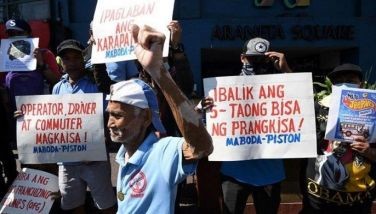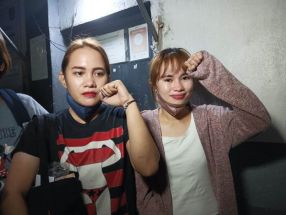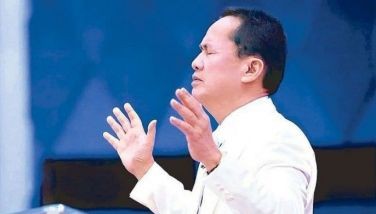Admin Code used as DAP legal basis
MANILA, Philippines - President Aquino apparently relied on the Administrative Code of 1987 as his legal basis for authorizing the use of nearly P32 billion in government savings for the controversial Disbursement Acceleration Program (DAP).
He gave such authority to Budget Secretary Florencio Abad on June 27, 2012 by approving a seven-page memorandum his budget chief sent him two days earlier on the pooling and use of savings and unobligated or unused funds.
The authority given to Abad covered the consolidation of savings and withdrawal of unused funds of state agencies and the realignment of such appropriations.
In his memorandum, the budget chief informed Aquino that the legal basis for the consolidation and realignment of such funds was the Administrative Code of 1987.
“Any savings in the regular appropriations in the General Appropriations Act for programs and projects of any department, office or agency, may, with the approval of the President, be used to cover a deficit in any other item of the regular appropriations,” Abad said quoting Section 39, Chapter 5, Book VI of the code.
He also cited a provision in Section 38 of the same Chapter 5, Book VI of the code: “The President is authorized to suspend or otherwise stop further expenditure of funds allotted for any agency, or any expenditure authorized in the General Appropriations Act.”
Aside from these mandates in the code, Abad – in his memorandum to Aquino – quoted Section 25, Article VI of the Constitution.
Such section provides that the president “may, by law, be authorized to augment any item in the general appropriations law from savings in other items of appropriations.”
In approving the annual general appropriations law or budget, Congress restates this constitutional provision as the legal authority for the president to augment any appropriation in the budget from savings.
No time frame
The constitutional and legal bases for DAP cited by Abad do not contain any timeframe on when the President can suspend expenditures, use savings or augment appropriations.
The budget chief had obviously assumed that Aquino could do any of these within the budget year. But the Supreme Court (SC) has a different view.
Under the SC ruling declaring parts of DAP unconstitutional, the high court said savings could be declared and unused funds could be withdrawn and realigned only at the end of every fiscal year.
The tribunal also banned “cross-border” realignments to other branches of government, meaning the executive branch cannot realign funds to the judiciary or Congress, and vice versa.
It also disallowed the use of unprogrammed appropriations without a certification from the national treasurer that funds are actually available.
In his memorandum, Abad informed Aquino that the government had billions in savings from unfilled positions and projects that had been completed or discontinued, and from slow-moving programs and projects.
He said such funds amounted to P31.962 billion and could better be used for high-impact infrastructure and fast-moving projects.
He proposed that P2 billion would be given to the Department of Public Works and Highways, P1.6 billion to the Coast Guard for its activities in the West Philippine Sea, P2.2 billion to the Philippine National Railways, P1.8 billion to the Department of Agrarian Reform, and P1 billion to Land Bank as credit facility for farmers.
Some P5 billion was to be allocated for tourism infrastructure, P4.1 billion for the premium contribution of personnel of the Department of Education to the Government Service Insurance System, P1.4 billion for the rehabilitation of LRT Lines 1 and 2, P2 billion for rural health clinics, P1 billion for rural electrification, P1.3 billion for job programs, and P8.3 billion for various local projects.
The House of Representatives was to be given P250 million for its legislative library and archive building project.
Militant groups claim that aside from the June 25, 2012 memo, Abad had two other submissions to the President on DAP, including one for 2011.
Unexplained withdrawal
The DBM has more explaining to do with its having withdrawn P475 million in DAP funds from DAR in early 2012.
Documents obtained by The STAR show that the funds were released to the “Office of the Secretary, Department of Agrarian Reform” in six separate special allotment release orders (SAROs).
A DBM source said the funds were intended for the projects of some senators for agrarian reform beneficiaries. The source could not identify the senators. A SARO is a DBM fund release document.
Three SAROs were for P100 million each, one for P70 million, another for P55 million, and the last one for P50 million.
They were all dated Dec. 6, 2011 and signed by DBM Undersecretary Mario Relampagos, who is facing graft charges before the Sandiganbayan in connection with his alleged involvement in the multibillion-peso pork barrel scam.
The SAROs indicated that the funds were not part of the “programmed” budget of DAR but for “additional program.”
In the fund release documents was a typewritten note saying, “This release is in accordance with OP approval dated Oct. 12, 2011.” OP stands for Office of the President.
The SAROs were accompanied by six separate notices of cash allocation (NCAs) advising DAR Secretary Virgilio delos Reyes that funds were immediately available for the senators’ projects. Relampagos signed the NCAs also on Dec. 6, 2011.
In government budgeting, it is not normal for actual cash to be released on the same day as SAROs. This is because the SARO serves as the document for an agency to start the process of procuring products or services, which includes bidding and which takes some time. An agency does not need actual cash to begin such a process.
Normally, cash is made available later and in installments, since there is the so-called “progress billing” in government.
Funds in a flash
In the case of the senators’ funds coursed through the office of the DAR secretary, the entire amount of P475 million was made available at the Land Bank-Quezon City Memorial Circle branch on the day the SAROs were released.
However, three months later, Relampagos withdrew the funds by issuing six separate “negative SAROs.”
A total of P370 million was withdrawn in four negative SAROs on March 15, 2012, with the remaining P55 million recalled more than a month later on April 30 and P50 million on June 25, 2012.
There was no stated reason for the recall of the funds in the negative SAROs. There was also no note that the withdrawal was upon OP approval.
Curiously, on the same day Relampagos withdrew the funds from DAR, the DBM issued SAROs for P425 million for the projects of Senators Jinggoy Estrada, Ramon Revilla Jr., Ferdinand Marcos Jr., Vicente Sotto III, and Juan Ponce Enrile.
Estrada, Revilla and Marcos were allocated P100 million each, while Sotto and Enrile got P70 million and P55 million, respectively.
The funds, coursed through the National Livelihood Development Corp. (NLDC), allegedly ended up with bogus foundations linked to alleged pork barrel scam mastermind Janet Lim Napoles.
Gondelina Amata, who is NLDC president, is charged with Estrada, Revilla, Enrile, Napoles, senior aides of the three senators, and other NLDC personnel before the Sandiganbayan for their alleged participation in the pork barrel scam.
NLDC is a subsidiary of Land Bank. Land Bank president Gilda Pico chairs NLDC but has not been dragged into the scam.
Not possible
Meanwhile, two senators whose projects had benefited from DAP in 2012 said it would not be necessary or possible for them to return funds they had never touched in the first place.
Senators Sergio Osmeña III and Alan Peter Cayetano said lawmakers were clueless that funds for their projects were released through DAP since they were not aware that such a program even existed at that time.
“We do not receive any funds. We are only given the right to identify the projects. How do we even return money that never went to our bank accounts? The funds go from the DBM to the beneficiaries. We only identify (the projects),” Osmeña said in an interview over dwIZ.
“For example, the funds went to (the construction of) schools. How do I return a school? If it went to shoulder the cost of dialysis, is it possible for me to get the medicine that went to the body of the person who underwent dialysis?” Cayetano, for his part, said.
Cayetano said the demand for the return of DAP-related funds should only be addressed to legislators who may have misused or stolen them.
– With Marvin Sy, Aurea Calica, Sheila Crisostomo
- Latest
- Trending






























